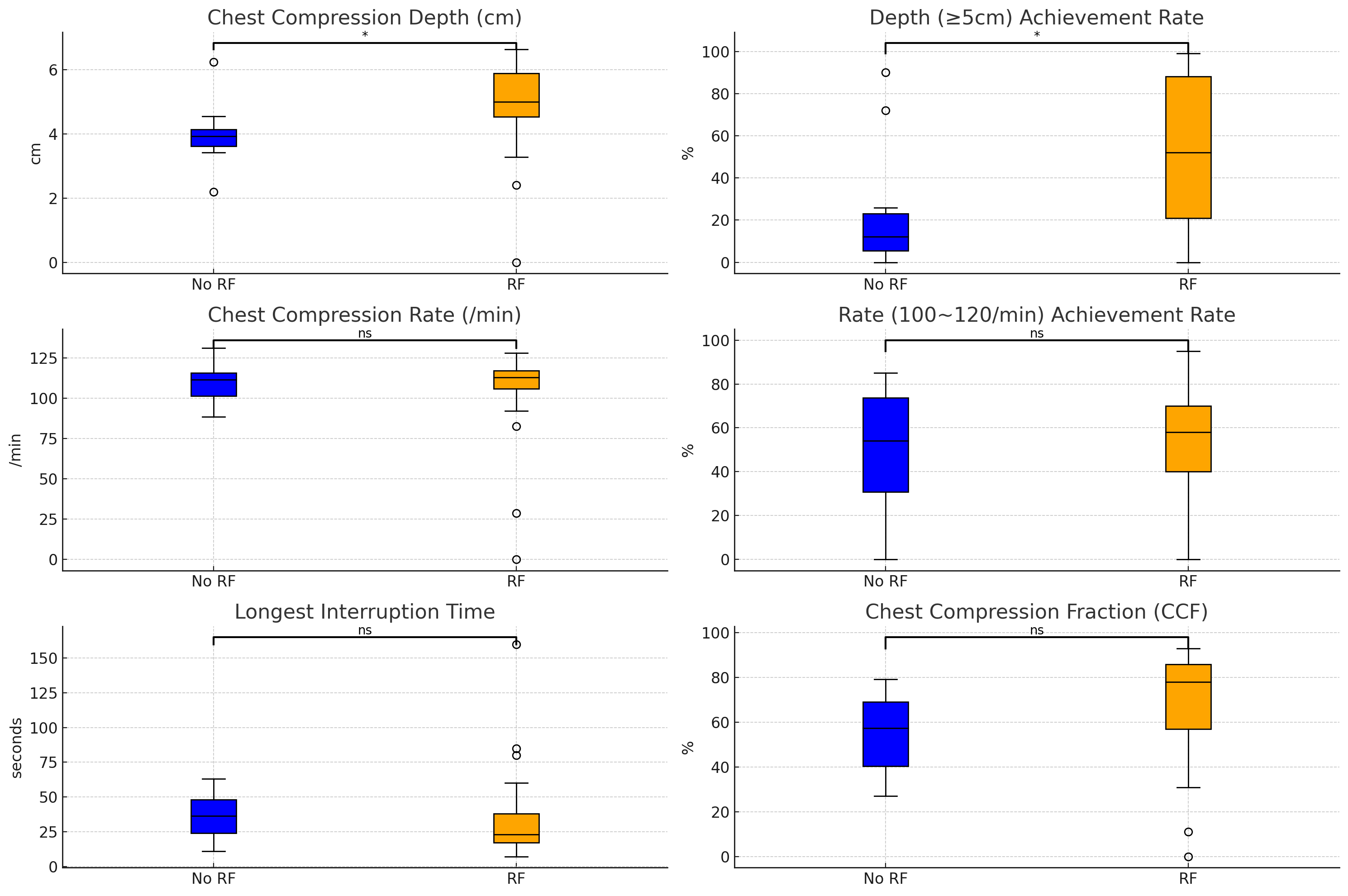Final ID: Sa405
Unlocking the Potential of Mechanical CPR: The Role of Real-Time Feedback Before Device Application
Abstract Body: Background: Current AHA guidelines do not recommend routine use of Mechanical CPR devices due to the decline in CPR quality during their preparation and application. However, Manual chest compressions during transport can reduce CPR quality. In situations where maintaining high-quality CPR is challenging, Mechanical CPR devices are essential. We hypothesized that real-time feedback (RF) could help maintain the quality of Manual CPR before Mechanical CPR devices are activated.
Objectives: To investigate the impact of RF on the quality of Manual CPR before the activation of Mechanical CPR devices.
Methods: This retrospective observational study included OHCA cases where Mechanical CPR using the LUCAS 3® device was performed between May 2023 and February 2024. We compared chest compression quality parameters, including Depth Achievement Rate (≥5cm) (%), Depth (cm), Rate Achievement Rate (100-120/min) (%), Rate (/min), Longest Interruption (s), and Chest Compression Fraction (CCF) (%) during Manual chest compressions before the application of the Mechanical CPR device between two periods, using the ZOLL X Series® monitor. During the first 5 months, RF was not used, and EMS teams could not see RF data, but chest compression quality parameters were recorded. During the subsequent 5 months, RF was displayed, and the same parameters were recorded.
Results: The results are summarized in the attached figure. There were 10 cases without RF and 37 with RF. The RF group showed significant improvements in depth achievement rate (≥5cm) and compression depth. The rate achievement rate (100-120/min) and compression rate were similar between groups. The longest interruption time was shorter in the RF group, and the CCF was higher, although these differences were not statistically significant. The median duration of Manual CPR before applying the Mechanical CPR device was longer in the RF group [382s, IQR 110-654] compared to the non-RF group [156s, IQR 67-283], p=0.065.
Conclusions: RF significantly improved the depth achievement rate and compression depth during Manual CPR before applying Mechanical CPR devices. Trends towards shorter interruption times and higher CCF in the RF group suggest RF may help maintain CPR quality. However, the retrospective nature and limited sample size may affect the generalizability of the results.
Objectives: To investigate the impact of RF on the quality of Manual CPR before the activation of Mechanical CPR devices.
Methods: This retrospective observational study included OHCA cases where Mechanical CPR using the LUCAS 3® device was performed between May 2023 and February 2024. We compared chest compression quality parameters, including Depth Achievement Rate (≥5cm) (%), Depth (cm), Rate Achievement Rate (100-120/min) (%), Rate (/min), Longest Interruption (s), and Chest Compression Fraction (CCF) (%) during Manual chest compressions before the application of the Mechanical CPR device between two periods, using the ZOLL X Series® monitor. During the first 5 months, RF was not used, and EMS teams could not see RF data, but chest compression quality parameters were recorded. During the subsequent 5 months, RF was displayed, and the same parameters were recorded.
Results: The results are summarized in the attached figure. There were 10 cases without RF and 37 with RF. The RF group showed significant improvements in depth achievement rate (≥5cm) and compression depth. The rate achievement rate (100-120/min) and compression rate were similar between groups. The longest interruption time was shorter in the RF group, and the CCF was higher, although these differences were not statistically significant. The median duration of Manual CPR before applying the Mechanical CPR device was longer in the RF group [382s, IQR 110-654] compared to the non-RF group [156s, IQR 67-283], p=0.065.
Conclusions: RF significantly improved the depth achievement rate and compression depth during Manual CPR before applying Mechanical CPR devices. Trends towards shorter interruption times and higher CCF in the RF group suggest RF may help maintain CPR quality. However, the retrospective nature and limited sample size may affect the generalizability of the results.
More abstracts on this topic:
Acceptability and Effectiveness of a Novel, Video-Based CPR and AED Education Program in Canadian Schools
Allan Katherine, Dhillon Santokh, Mcculloch Holly, Ruether Kim, Zotzman Jeanine, Blanchard Ian, Janczyszyn Mike, Wong Natalie, Oneil Emma, Sapp John
Airway Opening Index in Cardiopulmonary ResuscitationNassal Michelle, Carlson Jestin, Stephens Shannon, Panchal Ashish, Wang Henry, Smith Rachel, Idris Ahamed, Jaureguibeitia Xabier, Aramendi Elisabete, Elola Andoni, Daya Mohamud, Nichol Graham, Aufderheide Tom

